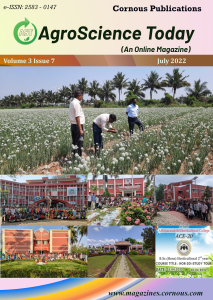Onion is one of the important bulbous vegetable crop grown in India and it is a vital constituent of Indian cookery. Indian average productivity is 16.80 Mt/ha. However when compared to other countries, the Indian average yield is very low. The main difference between the bulb and seed propagated types is, investment on seed component. In bulb propagated type, farmer requires 500 to 600 kg of seed bulbs for planting an acre which is higher in cost. Whereas in seed propagated type, it requires only one kg of seeds for an acre which is cheaper as compared to seed bulbs. This will minimize the cost of cultivation, reduction in diseases incidence, enhance the drought tolerance and more income to the farming community.
Protection of Plant varieties and Farmers Rights Act (PPV & FR) is a unique law that India has passed to safeguard plant varieties through registration. To protect plants from environmental effects and to use molecular markers that are dependable, quick and affordable, it is crucial to identify and register plant varieties. The traditional method for the identification of variety involves recording of morphological traits, which is time consuming, labor intensive and highly influenced by environmental factors. The extensive use of molecular markers in all the major crops has created a new opportunity for their application in the recognition and preservation of plant varieties.
Quantitative trait locus (QTL) mapping is an analysis of the number, genomic locations, effects, and interactions of quantitative trait loci (QTL). When examining a set of quantitative traits, QTL mapping looks at the link between genotype at various genomic regions and phenotype. Finding the chromosomal regions that significantly affect how quantitative traits differ among populations is the primary objective of QTL mapping. This localization is crucial for both the eventual identification of the implicated genes and our comprehension of the genetic mechanisms behind the variance.
Effective microorganism technology is a method in which mixed culture of beneficial microorganisms is applied to soil as an inoculant, which increases microbial diversity; enhance soil quality as well as growth, yield and quality of crops. The necessity for chemical fertilisers and pesticides is lowered since EM cultures expedite the decomposition of organic wastes, increase the availability of mineral nutrients and desirable organic compounds to plants, and augment the activity of beneficial microorganisms. Due to its eco-friendly nature and minimal demand on resources like inputs and money, EM has a pretty broad range of applications in many facets of human society. Therefore, effective microorganism technology can be considered as an effective method in organic fertilization.
Coconut is consumed in the daily diet in several part of the world. All parts of the coconut tree have medicinal properties. Many phytochemicals are present in different parts. Coconut water contains phenols and flavonoids. Pharmacological properties of coconut kernel, flower, husk, tender coconut water and virgin coconut oil were proved through in vitro and in vivo techniques. Ozone treatment and UV coupled polyamide membrane system could be used to improve shelf life of coconut water. Many value added products and nutraceuticals can be produced using coconut.
